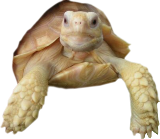
Riparian Farms

Care Sheet: Hermann's & Marginated Tortoises
Hermann's Tortoise (Testudo hermanni) and Marginated tortoise (Testudo marginata) are small European Species. There are two subspecies of hermann's tortoises. One subspecies grows to about 5 or 6 inches the other subspecies grows to 7 or 8 inches. The marginated tortoise grows from 9 to 11 inches. The care of both these species is very similar. They both come from a Mediterranean climate that is mild/temperate to subtropical. Neither tortoise digs a burrow but both species dig shallow pallets into soft earth or under bushes and debris to hide from the heat or cold. Both species naturally hibernate in the wild, but on warm winter days may become active.
When you receive your tortoise it should be immediately soaked in shallow lukewarm water for about 20 minutes. Hatchling tortoises should be housed indoors. They can be put outside to receive natural sunlight, but should be watched and be able to get out of the sun when they get warm (if not they could become over heated and die). Four or five inch tortoises can be kept outside during warm months when night temperatures are above 60 degrees and days are sunny. Your tortoise will do perfectly fine during the winter without being put into hibernation. In mild winter areas (minimum lows of above 20 degrees) they can be left outside to hibernate under protective piles of leaves, garden debris, or straw where it stays above freezing. In cold climate areas they can be placed in a box and hibernated in a storage room or closet that stays between 40 to 50 degrees.
Hatchling tortoises can be maintained in a large glass aquarium, or a large plastic box such as a sweater box. The aquarium should be lighted with a good UL bulb and there should be a basking light on one side of the aquarium or box. The temperature at night should be above 60 degrees and days should be above 80 degrees. The tortoises require a basking light to elevate their body temperature to 85 to 90 degrees which aid in digestion.
Herman's tortoises and marginated tortoises are grazers and herbivores. They do not eat meat of any kind and require very little fruit. Adult tortoises can be maintained in grass yards and lawns where there are a variety of edible weeds, flowers or other plants. No other supplements are required. If a grassy yard is not available adults can be fed dark green vegetables and commercial tortoise diets. If they are fed only dry foods (such as dry tortoise diets or dry leaves and grass) they must have water available every day. If the tortoises have fresh greens or grass available they should still be watered two or three times per week or more often if temperatures are high. They should always have shade available so they can get out of direct sun when they have warmed up. A hide box or turtle house is recommended.
Hatchling tortoises should be fed daily. A diet of chopped greens (kale, endive, mustard, dandelions, etc.) and/or a commercial tortoise diet (15 to 18 percent protein) should be fed to the tortoises. They should be soaked in shallow lukewarm water at least every other day. If your tortoise is kept warm fed and watered regularly, and given adequate room it should live for years. Small tortoises grow about 2 inches per year.